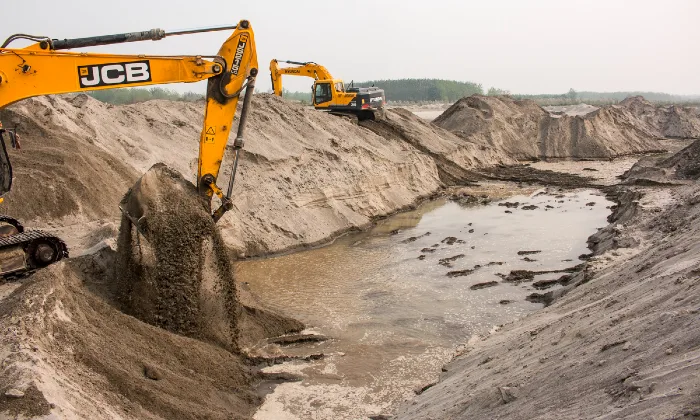While many of us find solace in the soft grains of beach sand or marvel at the towering skyscrapers in city skylines, few understand the invisible crisis that links the two: the global sand mining dilemma.
A seemingly mundane resource, sand, plays a pivotal role in our day-to-day lives. Yet, our insatiable demand for it is echoing through our planet’s ecosystems with a cry that’s impossible to ignore.
Picture this: a vast convoy of over a million dump trucks rumbling across the landscape, each filled to the brim with sand. This isn’t a scene from a dystopian novel; it’s the daily reality of our global sand consumption.
According to the United Nations Environment Programme (UNEP), we’re extracting a staggering 6 billion tons of sand from marine environments every year.
“It’s not sustainable. The amount of sand that we are withdrawing from the environment is considerable and has large impacts,” stated Pascal Peduzzi (pictured at the right), director of a UNEP center for analytics called GRID-Geneva.
He compared the problem to deforestation or overfishing, when people are using a resource faster than it can be replenished.

For many, concrete is merely the foundation of urban jungles. Yet, it’s everywhere: from the pathways we stroll upon to the towering skyscrapers that define our cityscapes. After water, it’s the world’s most consumed substance, with sand as its vital ingredient.
This doesn’t even account for its role in crafting glass and semiconductor chips. Our relentless urban expansion is pushing nature’s boundaries, transforming habitats into artificial beaches and broadening city limits.
But why should we be concerned?
Our defensive barricade against the encroaching sea — our coastlines — are under siege. With sea levels on the rise, communities are scrambling to fortify their shores, often using sand as the primary bulwark.
Yet, this might be a race we’re destined to lose, as the very sand we depend on for protection could become a scarce commodity.
Marine life isn’t spared either. The dredging that extracts sand disrupts delicate oceanic ecosystems. Marine habitats are upended, and the aftermath could be irreparable for numerous species. The additional noise pollution and water murkiness exacerbate an already dire situation.
Recognizing the urgency, UNEP spearheaded the ‘Marine Sand Watch’, a data platform harnessing the power of artificial intelligence and advanced vessel tracking systems. This initiative offers a lens into the world of sand mining, highlighting its expansive footprint.
Moreover, in a proactive move last year, UNEP resolved to bolster its comprehension of sand extraction through GRID-Geneva, aiming to inform and shape global policies effectively.
And in Uganda, sand mining is endangering their wetlands as the demand for cheap concrete primarily for construction projects in Saudi Arabia continues to boom. More on that in the video below…
Interestingly, regions such as China’s coast and the US’s East Coast are witnessing heightened sand dredging. These are zones with bold visions for renewable energy, especially offshore wind energy.
More To Discover
- Self-Heating Concrete Could Save Billions by Melting Snow Without Salt or Effort
- How Leftover Coffee is Supercharging Green Building (Read it Scientifically or Keep it Fun)
- Australia’s Coffee-Concrete: 30% Stronger Pavement With Recycled Coffee Grounds
- Swiss Study Reveals That Fungi Can Boost Crop Yields by 40%

However, unstable sandy foundations raise concerns: the future turbines, our beacon for a greener tomorrow, might themselves be at risk due to shifting sands.
So, when you next step onto a beach or admire a city skyline, reflect on the silent crisis unfolding beneath. Sand, seemingly trivial, serves as a reminder of our intricate relationship with nature and our shared duty to preserve it.



















